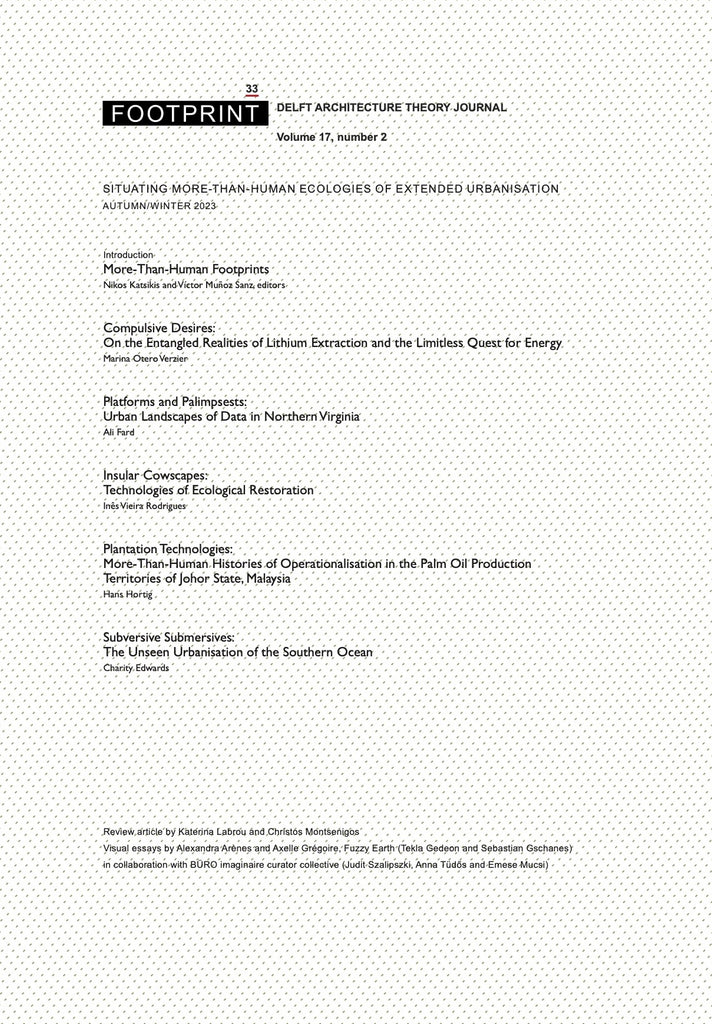Your cart is currently empty!
New titles
Footprint 33 Situating More-Than-Human Ecologies of Extended Urbanisation
++++++
+++Nikos Katsikis, Victor Muñoz Sanz [eds.]+++
Editorial Board Robert Alexander Gorny, Jorge Alberto Mejía, Nelson Mota, Victor Muñoz Sanz, Dulmini Perera, Léa-Catherine Szacka
For a subscription: Bruil & Van de Staaij
+++
| Footprint is a peer-reviewed architecture and theory academic journal
Footprint 33 explores techno-natural spatialities and materialities found across operational landscapes of primary production. To the extent that these landscapes are increasingly automated and digitised, production and circulation practices are becoming more capital intensive and even less labour-intensive. While amplifying the precarity of human labour, this process relies on appropriating the work of more-than-human assemblages of machines, plants, animals and microorganisms. Central to the focus of this issue is understanding the way these processes are grounded in specific architectural and landscape configurations. In this way, we also aim to complement the debates on past issues of Footprint, offering an investigation of the impact of technological transformations beyond the concentrated landscapes of human inhabitation.
Footprint is a peer-reviewed journal presenting academic research in the field of architecture theory. The journal encourages the study of architecture and the urban environment as a means of comprehending culture and society, and as a tool for relating them to shifting ideological doctrines and philosophical ideas. The journal promotes the creation and development – or revision – of conceptual frameworks and methods of inquiry. The journal is engaged in creating a body of critical and reflexive texts with a breadth and depth of thought which would enrich the architecture discipline and produce new knowledge, conceptual methodologies and original understandings. Footprint is grateful to our peer reviewers, who generously offered their time and expertise. In this issue, the following papers were peer-reviewed: ‘Architectures of Thought: Negentropy, Metabolics and the General Ephemeral’, ‘Forest Semiosis: Plant Noesis as Negentropic Potential’, ‘Being in the Hyper City, and the Posthuman Body’, ‘Transductive Architecture: What an Organology Produces – the Case of Le Corbusier’.
€25.00
Footprint 33 Situating More-Than-Human Ecologies of Extended Urbanisation
€25.00
Architecture / Bookazines / Series / New titles / Theory / Urbanism
Editorial Board Robert Alexander Gorny, Jorge Alberto Mejía, Nelson Mota, Victor Muñoz Sanz, Dulmini Perera, Léa-Catherine Szacka
For a subscription: Bruil & Van de Staaij
| Footprint is a peer-reviewed architecture and theory academic journal
Footprint 33 explores techno-natural spatialities and materialities found across operational landscapes of primary production. To the extent that these landscapes are increasingly automated and digitised, production and circulation practices are becoming more capital intensive and even less labour-intensive. While amplifying the precarity of human labour, this process relies on appropriating the work of more-than-human assemblages of machines, plants, animals and microorganisms. Central to the focus of this issue is understanding the way these processes are grounded in specific architectural and landscape configurations. In this way, we also aim to complement the debates on past issues of Footprint, offering an investigation of the impact of technological transformations beyond the concentrated landscapes of human inhabitation.
Footprint is a peer-reviewed journal presenting academic research in the field of architecture theory. The journal encourages the study of architecture and the urban environment as a means of comprehending culture and society, and as a tool for relating them to shifting ideological doctrines and philosophical ideas. The journal promotes the creation and development – or revision – of conceptual frameworks and methods of inquiry. The journal is engaged in creating a body of critical and reflexive texts with a breadth and depth of thought which would enrich the architecture discipline and produce new knowledge, conceptual methodologies and original understandings. Footprint is grateful to our peer reviewers, who generously offered their time and expertise. In this issue, the following papers were peer-reviewed: ‘Architectures of Thought: Negentropy, Metabolics and the General Ephemeral’, ‘Forest Semiosis: Plant Noesis as Negentropic Potential’, ‘Being in the Hyper City, and the Posthuman Body’, ‘Transductive Architecture: What an Organology Produces – the Case of Le Corbusier’.












